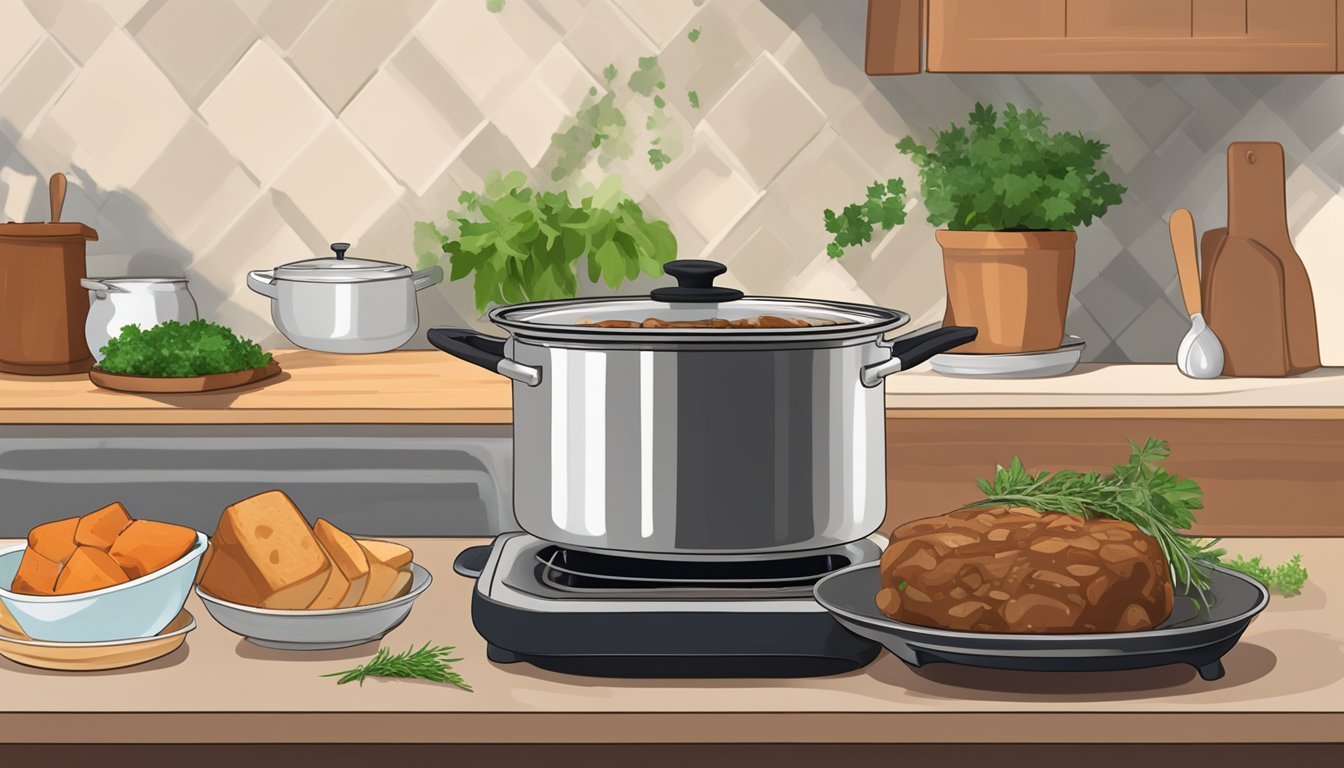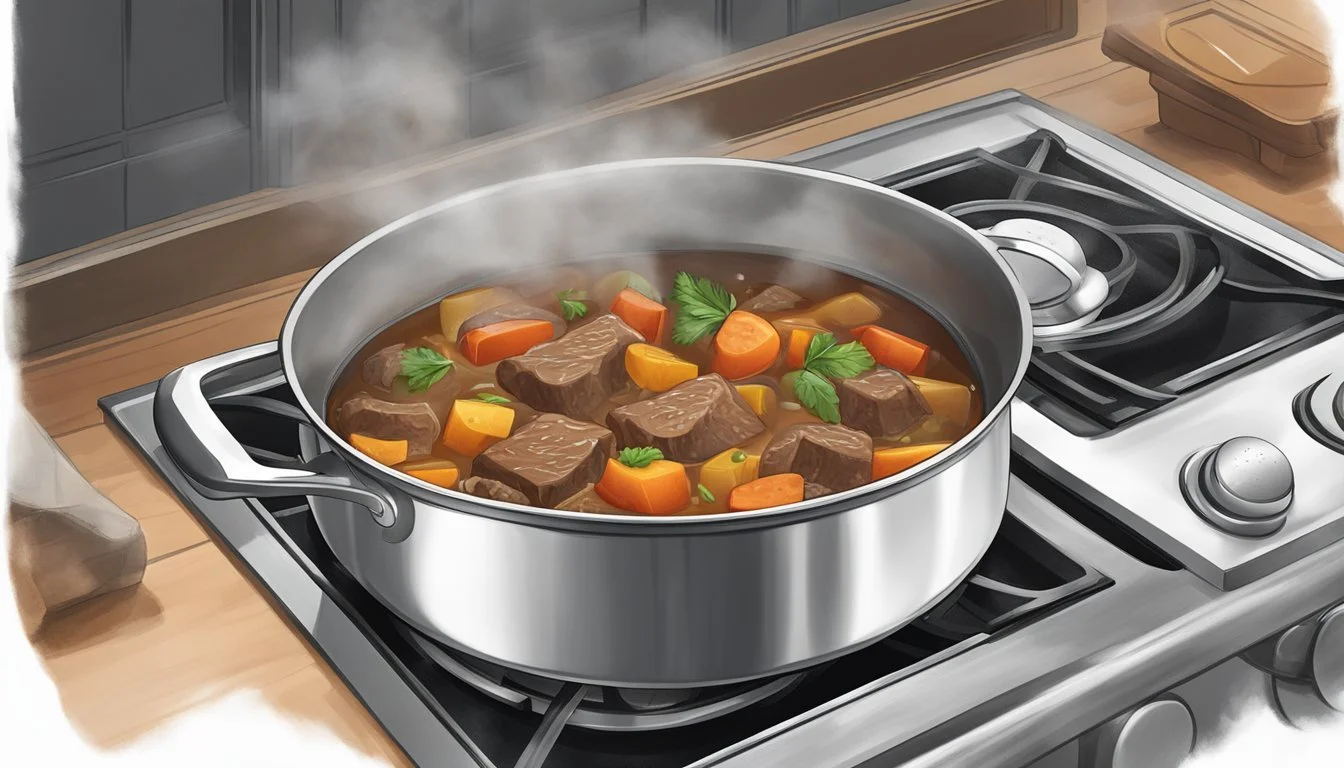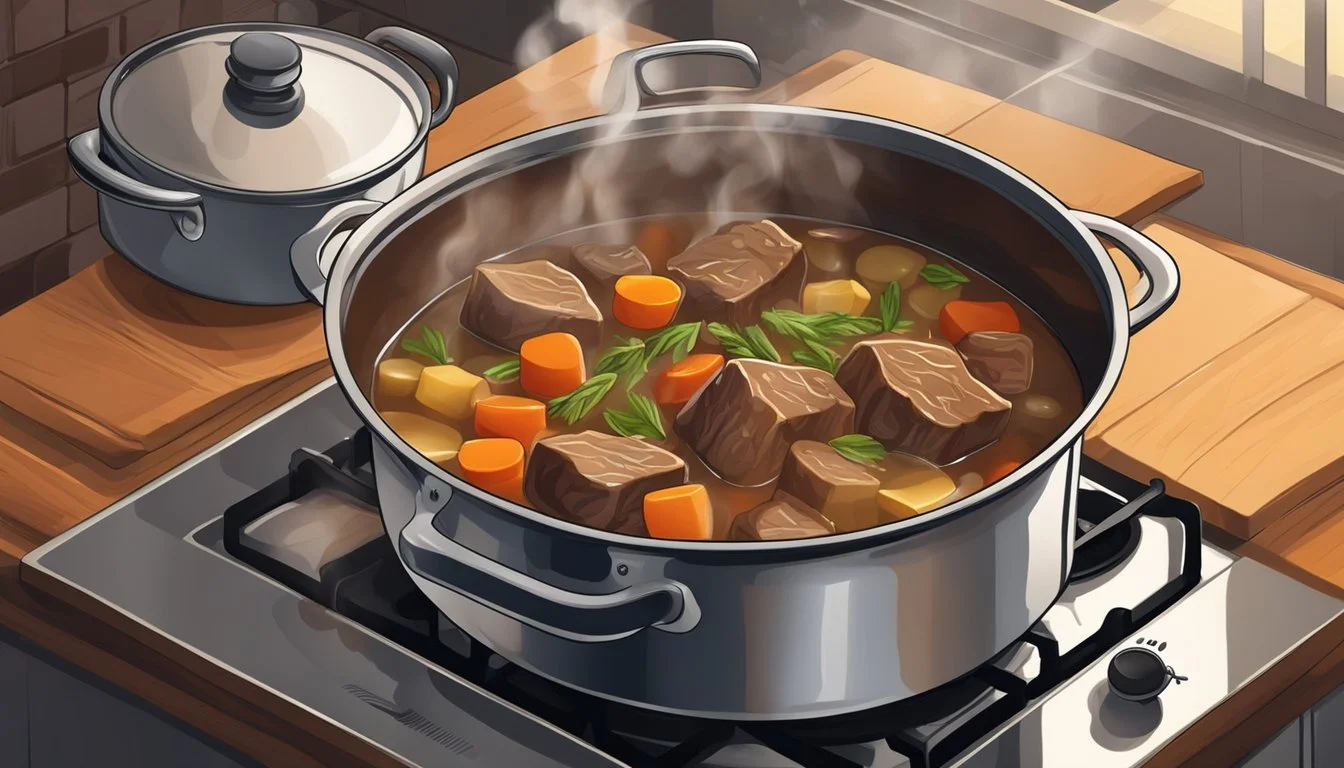Best Way to Reheat a Beef Stew
Tips for Flavorful Warmth
Reheating beef stew (What wine goes well with beef stew?) properly is key to preserving its richness and depth of flavor. When beef stew (What wine goes well with stews?) is made, the slow cooking process allows the flavors to meld together, creating a hearty and comforting dish. Preserving the quality of this intricate blend of flavors during reheating can be a challenge, but with the right techniques, it is possible to revive the stew to its original savory state. Attention to detail is paramount in order to maintain the texture and taste of the beef, vegetables, and broth.
One of the best ways to reheat beef stew is by using the stovetop. This method allows for gentle heating, which is essential for keeping the integrity of the beef and vegetables intact. It is advisable to reheat the stew over a low temperature, stirring occasionally, which promotes even heat distribution without causing the ingredients to break down or the stew to stick to the bottom of the pot. Adding a bit of water or broth can replenish lost moisture and avoid a reduction in the stew's quality. This approach can help restore the beef stew to the desired warmth, with its flavors as robust as when originally prepared.
An alternative method that yields favorable results is reheating beef stew in the oven. This technique involves transferring the stew into an oven-safe dish, covering it with a lid or aluminum foil to trap moisture, and warming it at a low temperature. The slow and steady heat from the oven envelops the stew, enhancing its flavors while gently bringing it to the ideal temperature. This process takes longer than reheating on the stovetop but can further enhance the stew's flavor, making it worth the wait.
Understanding the Basics of Beef Stew
Beef stew is a classic dish that embodies a harmonious blend of meat, vegetables, and broth, transformed through slow cooking into a rich, flavorful meal. This section focusses on its composition, optimal reheating techniques, storage methods, equipment choices, and safety measures to maintain its essence.
Composition and Structure of Stew
Beef stew is primarily composed of meat—usually tougher cuts of beef that soften during cooking—vegetables like potatoes, carrots, and onions, and a broth or sauce that binds the ingredients. The slow cooking process allows flavors to meld, and both the fat and gelatin from the meat contribute to the stew's velvety texture.
Importance of Reheating Temperature
Reheating beef stew should be done gently and gradually to preserve its flavors and textures. A moderate temperature allows the internal temperature of the stew to reach 165°F, the point at which it's considered safely reheated. Overheating can cause the meat to toughen and vegetables to become mushy.
Storage Techniques Prior to Reheating
For best results, beef stew should be stored in the refrigerator within two hours of cooking to prevent the growth of harmful bacteria. It can remain in the fridge for 3-4 days or in the freezer for up to 3 months if stored properly in vacuum-sealed containers, freezer bags, or airtight containers.
Refrigerator Storage:
Cool down to room temperature.
Transfer to an airtight container.
Seal and refrigerate.
Freezing Guidelines:
Allow stew to cool.
Portion as desired.
Store in freezer-safe containers.
Selection of Reheating Equipment
The optimal reheating method depends on the equipment at hand. A stove and a saucepan are preferred for even heat distribution, while an oven can reheat larger quantities uniformly. A microwave—for convenience—is suitable for smaller servings, using a microwave-safe dish. Slow Cookers and Instant Pots are also effective but require a longer time.
Health and Safety Considerations
When reheating beef stew, it's imperative to reach an internal temperature of 165°F to ensure food safety and the elimination of potential foodborne illness. Always stir periodically to prevent uneven heating, and avoid cross-contamination with raw foods to prevent the spread of bacteria. Keep moisture levels balanced to preserve the flavor and texture, adding a slight amount of water or broth if necessary.
Preparatory Steps Before Reheating
Before diving into the reheating process, it's essential to prepare the beef stew properly to preserve its rich flavors and ensure food safety. This involves bringing the stew to the right temperature, assembling cooking tools, and making any necessary ingredient and flavor adjustments.
Thawing and Bringing Stew to Initial Temperature
If the beef stew is frozen, it should be thawed safely. One way is by transferring it from the freezer to the refrigerator and allowing it to thaw for several hours or overnight. For a quicker method, it can be immersed in cold water, ensuring that the stew is in a leak-proof package, and changing the water every 30 minutes. When the beef stew reaches refrigerator temperature, it's ready for the next step.
Gathering Necessary Tools
The right tools are required for a successful reheating process. Depending on the chosen reheating method, the individual may need:
Pot: If using a stove, gather a pot adequate to hold the stew without spilling.
Oven-Safe Dish: For oven reheating, an oven-safe dish with a lid or suitable covering material is necessary.
Microwave-Safe Container: If the microwave is the preferred method, a microwave-safe container is required.
Stirring Utensil: A spoon or spatula for stirring the stew is important to ensure even heating.
Food Thermometer: Ensuring the stew reaches a safe internal temperature of 165°F (74°C) is a must for food safety.
Ingredient and Seasoning Adjustments
The flavor profile of the stew might change after storage. To enhance the stew before reheating:
Taste the stew after bringing it to initial temperature and decide if additional spices or seasonings are needed.
Add required seasonings such as salt, pepper, or herbs, being mindful of the original flavor.
Consider additional ingredients that may need to be added to improve the stew's texture and consistency, like a splash of broth or water.
Reheating Methodologies
Reheating beef stew properly can greatly enhance its flavor and texture. This section covers various methods to ensure your reheated stew is as delicious as when it was first cooked.
Stovetop Reheating Techniques
Reheating beef stew on the stovetop is ideal for maintaining its consistency. Place the stew in a pot over low heat to avoid burning. Stirring regularly allows the stew to heat evenly. For extra moisture, add a small amount of broth or water.
Oven Reheating Procedures
For an oven method, preheat to 350°F (175°C). Transfer the beef stew into an oven-safe dish, cover with foil to retain moisture, and bake. This approach can enhance the texture and color of the stew, making it appealing and flavorful.
Preparation: Preheat oven.
Duration: Bake for 30-45 minutes.
Microwave Reheating Strategies
Microwave reheating is quick and convenient. Use a microwave-safe container with a lid to avoid splattering and retain moisture. Heating in short intervals with stirring helps distribute heat throughout the stew.
Intervals: Heat for 3 minutes, stirring every 60 seconds.
Alternative Reheating Approaches
Other methods like slow cookers, sous vide, or the Instant Pot can also reheat stew effectively. Slow cookers gently reheat over several hours. Sous vide, with a water bath, ensures consistent temperature, perfect for small portions or frozen stew. An Instant Pot can reheat quickly using the steam function.
Slow Cooker: Set on low for a couple of hours.
Sous Vide: Seal in a bag, submerge in water bath set to a precise temperature.
Instant Pot: Use the steam function for a fast reheating option.
Dealing with Special Cases
When dealing with frozen beef stew, thawing before reheating is essential. Add additional ingredients like herbs or spices during the reheating process to refresh the stew's flavor profile. Each method can be adjusted to suit the stew's specific needs.
Optimizing Flavor and Texture
Properly reheating beef stew is pivotal to preserving its robust flavor and tender texture. The process involves careful moisture control, appropriate heating, and consistent stirring to ensure each spoonful is as satisfying as the last.
Adjusting for Moisture Retention
A key factor in maintaining the quality of beef stew is ensuring adequate moisture retention. To prevent the sauce from becoming too thick or evaporating, one might need to add a little broth or water before reheating. This adjustment helps to preserve the moisture of the meat and vegetables while keeping the sauce's consistency ideal for serving.
Tip: Add broth in small increments to avoid diluting the flavors.
Balancing Heat to Prevent Overcooking
Reheating on low heat is essential to warm the stew thoroughly without risking overheating. A gentle simmer on the stovetop or a steady temperature in the oven (about 350°F) is recommended. High heat can lead to scorching and toughen the meat, compromising both texture and flavor.
Oven: Preheat to 350°F and cover the dish with foil.
Stovetop: Use the lowest setting to simmer and avoid scorching.
Stirring and Agitation to Maintain Consistency
Regular stirring during the reheating process is crucial for even heat distribution and maintaining the stew's consistency. This prevents certain sections from overheating while others remain cold. It also ensures that the flavor and texture are evenly enhanced throughout the stew.
Microwave: Stir periodically if using, for even heating.
Stovetop/Oven: Stir occasionally to maintain an even texture and temperature throughout.
Serving and Accompaniments
When reheating beef stew to enhance its flavor, it is just as crucial to consider the right serving temperature, complementary sides, and the addition of fresh garnishes. These elements ensure that the stew maintains its savory profile and is enjoyed to its fullest.
Proper Serving Temperature
Beef stew is best served at an internal temperature of 160°F to ensure it is heated through and safe to consume. One should use a food thermometer to check the temperature before serving. Serving the stew too cool may dampen its flavors, while too hot can affect the texture and comfort of enjoying the meal.
Suitable Sides and Pairings
The richness of beef stew pairs exceptionally well with:
Starchy Sides:
Rice: Its neutral taste complements the robust flavors of the stew.
Mashed Potatoes: Its creamy texture contrasts nicely with the chunkiness of the stew.
Crusty Bread: Perfect for sopping up the savory juices.
Vegetables:
Steamed or roasted vegetables provide a healthy balance to the meal.
Adding Freshness with Garnishes
To lift the stew’s flavor and add a final touch of freshness, consider:
Dairy: A dollop of sour cream can add a tangy contrast.
Herbs and Spices: Freshly chopped parsley or chives (how long do chives last?), as well as a pinch of additional seasonings, can enhance the stew’s aroma and taste.
Onions: Crispy fried onions or fresh green scallions offer a crunchy texture and a sharp flavor that cuts through the richness of the stew.
Post-Reheat Storage and Safety
After enjoying a reheated beef stew, it's crucial to store leftovers properly to maximize flavor and ensure safety. The key is to refrigerate or freeze the stew promptly, prevent waste, and protect against foodborne illness.
Storing Leftover Reheated Stew
Leftovers should be cooled to room temperature within two hours and then stored in the refrigerator. Portion the stew into shallow containers to allow for quick cooling. The stew can safely be stored in the refrigerator for 3-4 days. For longer-term storage, package the stew in freezer-safe bags or containers, label them with the date, and place them in the freezer, where they can be stored for 2-3 months.
Preventing Food Waste
Consume first: Prioritize eating refrigerated leftovers within a few days to minimize waste.
Freeze in portions: Freeze leftover stew in individually sized servings to make it more convenient to thaw and reheat later, thereby reducing the likelihood of discarding unused portions.
Ensuring Long-Term Food Safety
Freezing leftover stew properly is paramount to prevent the growth of harmful bacteria and avoid foodborne illness.
Temperature: Ensure the freezer is set below 0°F (-18°C) to preserve the stew safely.
Airtight: Use airtight packaging to prevent freezer burn and preserve quality.
Thaw safely: Thaw frozen stew in the refrigerator or by using the microwave's defrost setting, not at room temperature, to avoid the danger zone for bacterial growth.
Implementing these storage practices ensures that the beef stew remains both enjoyable and safe upon subsequent reheating and consumption.
Concluding Tips and Best Practices
Reheating beef stew requires care to maintain its rich flavor, nutrition, and appealing color. The following tips and best practices can help individuals enjoy a satisfying meal while ensuring food safety and quality.
Summary of Key Reheating Tips
Oven Reheating: Heat at a low temperature, around 325°F, for 25-30 minutes in an oven-safe dish covered with a lid or aluminum foil to retain moisture.
Stovetop Reheating: Simmer the stew in a pot over low heat, occasionally stirring, adding broth or water as needed to reach the desired consistency without drying out.
Common Mistakes to Avoid
Overheating: High temperatures can cause the ingredients in the stew to break down, leading to loss of flavor and a less appealing texture.
Undercooking: Insufficient heating might not only lead to lukewarm stew but also poses food safety risks.
Personalizing Stew Reheating Techniques
Each individual should consider their own preferences when reheating stew. While one may prioritize efficiency, another might focus on the quality or flavor enhancements their particular recipe requires.
Adding a thickening agent like flour or cornstarch mixed with water can help restore consistency.
Extended Insights for Reheating Enthusiasts
For those seeking to perfect their reheating method, focus on:
Cost-Effectiveness: Utilizing the most energy-efficient appliance, such as a microwave, can save on utility bills.
Nutrition: Gentle reheating on the stove or oven can help to preserve the nutritional content of the beef stew.






